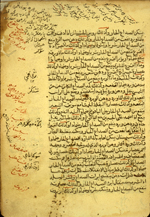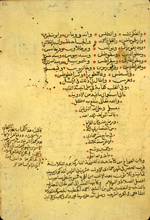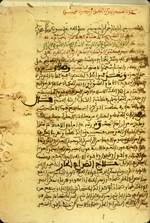Catalogue: Medical Therapeutics
-
 Mukhtaṣar
Tadhkirat al-Suwaydī (MS A 45)
Mukhtaṣar
Tadhkirat al-Suwaydī (MS A 45) - (The Epitome of Suwaydi's 'Memorandum Book')
- مختصر تذكرة السويدى
- by ‘Abd al-Wahhāb ibn Aḥmad al-Sha‘rānī (d. 1565/973)
- عبد الوهاب ابن احمد الشعرانى
Primarily known for his mystical writings, the 16th-century Egyptian scholar al-Sha‘rānī also composed in 1546/953 a popular epitome of a 13th-century treatise by al-Suwaydi concerned with medicinal substances. The author of the treatise that al-Sha‘rānī was epitomizing, al-Suwaydī, was a physician and philosopher active in Cairo and in Damascus. Suwaydī, a pupil of Ibn al-Bayṭār, died in Damascus in 1292/690, having composed a treatise on synonyms for plant names, a treatise on the medical uses of stones, and a memorandum book (Tadhkirah) in which he recorded recipes and procedures using various medicaments extracted from a large number of Islamic, Greek, and other sources.
It was the latter book that al-Sha‘rani epitomized in his Mukhtasar. For the life and writings of al-Sha‘rani, see GAL vol. 2, pp. 335-8 [441-5]. For al-Suwaydī, see GAL vol. 1, p. 493 [650] no. 38, and Ullmann, Medizin, p. 284.
In al-Suwaydī's original 13th-century treatise, the recipes were arranged according to the location of the complaint to be treated, that is, from head to foot, and al-Sha‘rānī maintains the same arrangement in his 16th-century short version. Throughout the treatise, magical and occult remedies play a prominent role.
NLM has two copies of this popular epitome. In one of the NLM copies, MS A 45, it is stated that the author completed the epitome on 17 Jumadá II 953 [= 4 March 1546].
For other copies, see Iskandar, "Wellcome, pp. 150-151, and GAL vol. 1, p. 493 [650] no. 38.I.a.
Mukhtaṣar Tadhkirat al-Suwaydī (MS A 45)
Illustrations
The opening of a popular epitome by the Egyptian mystic al-Sha‘rānī (d. 1565/973) of a "Memorandum Book" (Tadhkirah) written by al-Suwaydī, who died in Damascus in 1291/690. The treatise is concerned with remedies for various diseases, arranged in sequence from head to foot according to the location of the complaint. The copy was made in 1629/1038.
The colophon of a copy completed on 20 Jumadá I 1038 [= 15 January 1629] of a popular epitome by the Egyptian mystic al-Sha‘rānī (d. 1565/973) of a "Memorandum Book" (Tadhkirah) written by al-Suwaydī, who died in Damascus in 1291/690. The treatise is concerned with remedies for various diseases, arranged in sequence from head to foot according to the location of the complaint. On this folio there is also an extensive collation note dated 6 Rajab 1038 [= 1 March 1629]
Physical Description
Arabic. 131 leaves (fols. 2b-132a). Dimensions 20.5x 15.2 (text area 14.6 x 8.7) cm; 25 lines per page. There is no title page; the text states (fol. 2b) that the treatise epitomizes the Tadhkirah (Memorandum book) of al-Suwaydī. The author's name is not given in manuscript. The text is identical to NLM MS A 45.1 (catalogued below), where the author's name is given and also to London, Wellcome Library for the History and Understanding of Medicine, MS Arab. 79 (Iskandar, "Wellcome", p. 150).
This copy is dated in the colophon (fol. 132a), where it is said that the copyist ‘Alī ibn al-shaykh Aḥmad al-Ḥaṭib al-Ḥaḍarī al-Mudarris al-Shāfi‘ī completed it on 20 Jumadá I 1038 [= 15 January 1629].
A complete copy. On fol. 132a it is stated that the author completed the epitome on 17 Jumadá II 953 [4 March 1546] (fol. 132a). The text is written in medium-small naskh script. It is written in black ink with headings in red and red overlinings. There are catchwords.
The copy has been collated, and there is an extensive collation note dated 6 Rajab 1038 [= 1 March 1620] in the margin of fol. 132a. There are marginalia in several hands including some marginal corrections.
The beige paper is slightly worm-eated.
The volume consists of 133 leaves. Fols. 1a-2b and 132b-133b contain miscellaneous notes and recipes in Arabic and Persian. The endpapers also contain recipes.
Provenance
The volume was purchased in 1941 by the Army Medical Library from A. S. Yahuda, who acquired it from a dealer in Aleppo (ELS No. 1724; Med. 105).
References
Schullian/Sommer, Cat. of incun. & MSS., entry A45, p. 312.
NLM Microfilm Reel: FILM 48-121 no. 2
 Mukhtaṣar Tadhkirat al-Suwaydī (MS A 45.1, item 1)
Mukhtaṣar Tadhkirat al-Suwaydī (MS A 45.1, item 1)
Illustrations
The opening of a popular epitome by the Egyptian mystic al-Sha‘rānī (d. 1565/973) of a "Memorandum Book" (Tadhkirah) written by al-Suwaydi, who died in Damascus in 1291/690. The treatise is concerned with remedies for various diseases, arranged in sequence from head to foot according to the location of the complaint. The copy is undated, probably of the 18th century, and was made in North Africa.
Physical Description
Arabic. 81 leaves (fols. 1a-81b). Dimensions 20.5 x 14.5 (text area 15.5 x 9) cm; 23 lines per page. The title is given as Kitāb Mukhtaṣar al-Tadhkirah in the first line of fol. 1a and again on fol 81b, line 20. The name of the author of the treatise being epitomized is given on fol. 1a as ‘Izz al-Dīn Ibrāhīm ibn Muḥammad al-Suwaydī. The tail of the manuscript has written upon it: al-Sha‘rani fī al-tibb.
The copy is undated and unsigned. The appearance of the paper, script, and ink suggests an 18th-century date.
A complete copy. The text is written in a medium-large, somewhat awkward, North Africa (Maghribi) script in black ink with headings in red and green. There are red and green overlinings and occasional green-dot text stops.
The text has been collated; there is a collation note on fol 81b. There are marginal corrections and marginalia in several hands, including that of the collator.
The thin, ivory paper has horizontal thin laid lines and vertical single chain lines; no watermarks were observed. The edges have been trimmed from their original size. The paper is now very fragile and very wormeaten.
The volume consists of 204 leaves. Item 1 (fols. 1a-81b) is al-Sha‘rānī's epitome of the Tadhkirah by al-Suwaydī here catalogued; item 2 (fols. 124a-204b) is the commentary by ‘Alī ibn ‘Abd Allāh ibn Haydūr on the poem by Ibn Sīnā [Avicenna] (MS A 45.1, item 2); and item 3 (fols. 124a-204b) is a treatise on materia medica attributed to Yūḥannā ibn Bukhtīshū‘ (MS A 45.1, item 3). All three items were copied by the same hand.
Provenance
No information is available on provenance nor on when it entered the collections at NLM.
Binding
The volume is bound in pasteboards with envelope flap, covered in red leather. The covers have a blind stamped medallion with gilt edging design and vertical line, surrounded by three concentric frames with the inner corners marked with gilt stamped flower designs. The fore-edge flap is stamped with the same flower design. The envelope flap has a medallion and frame design similar to that on the covers. There are modern pastedowns and endpapers. The spine has been repaired.
References
Uncatalogued and unpublished. Not in Schullian/Sommer.
NLM Microfilm Reel: none














